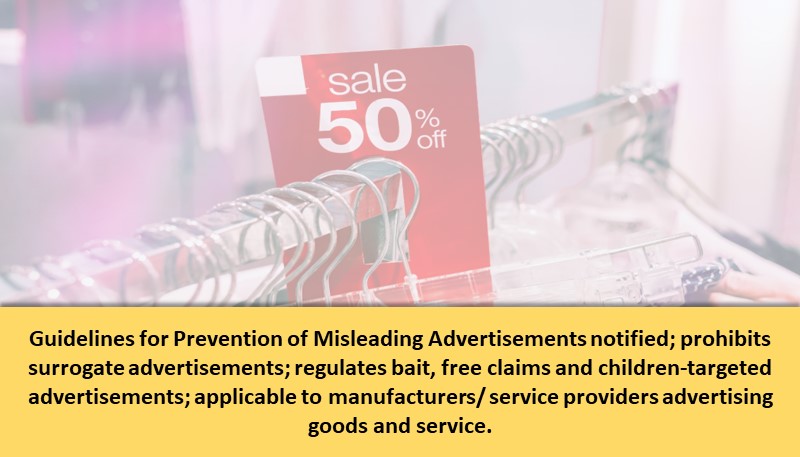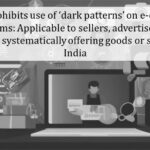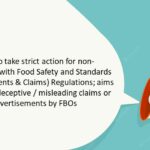The Central Consumer Protection Authority has notified the Guidelines for Prevention of Misleading Advertisements and Endorsements for Misleading Advertisements, 2022 (Guidelines). The Guidelines aim to protect against false or misleading advertisements and endorsements.
Applicability of the Central Consumer Protection Authority Guidelines
The guidelines apply to all advertisements regardless of form, format or medium to:
- manufacturer / service provider / trader whose goods, products or services are the subject of an advertisement
- advertising agency and endorser whose services are availed for the advertisement of such goods, product or service.
Key Compliance Obligations
Conditions for valid and non-misleading advertisement:
- contains truthful and honest representations;
- does not mislead consumers by exaggerating the accuracy, scientific validity or practical usefulness or capability or performance or service of the goods / product;
- does not present any of the legal rights of consumers as a distinctive feature of the advertiser’s offer;
- does not suggest that the claims made in it are universally accepted if there is a significant division of informed or scientific opinion pertaining to such claims;
- does not mislead about the nature or extent of the risk to consumers’ personal security or that of their families if they fail to purchase the advertised product or service;
- does not mislead consumers based on claims that are not independently substantiated but are based merely on the content of a publication;
- is compliant with other rules and regulations prescribed by law.
Note: Occasional and unintentional lapses in the fulfilment of the advertised promise or claim while carrying out mass manufacture and distribution of goods and services may not invalidate the advertisement provided that prompt action is taken to make good the deficiency to the consumer; proportion of product failures is within generally acceptable limits and if such promise or claim may be fulfilled by a typical specimen of the product advertised.
Bait advertisements
Bait advertisements* are those advertisements in which goods, product or service is offered for sale at a low price to attract consumers.
Conditions for Bait advertisements:
- should not entice customers to purchase goods, products or services without a reasonable prospect of selling such advertised goods, products or services at the price offered;
- advertiser (includes manufacturer and service provider of goods, products and services) is required to ensure adequate supply of goods, products or services to meet foreseeable demand generated by the advertisement;
- in the event there is limited availability of the advertised product or service, the same should be clearly specified in the advertisement;
- such advertisement should not mislead consumers about the market conditions with respect to the goods, products or services or the lack of their availability in order to induce consumers to purchase such goods, products or services at conditions less favourable than normal market conditions.
Advertisements prohibited by law
Surrogate* and indirect advertisement (advertisement of goods or services with direct or indirect references to products whose advertising is otherwise prohibited or restricted by law) is prohibited;
Note: Use of a brand name or company name which may also be applied to goods, product or service whose advertising is prohibited or restricted shall not be considered to be surrogate advertisement or indirect advertisement, if such advertisement is not otherwise objectionable as per the provisions set out in the Guidelines.
Conditions for Free claims advertisements
- such advertisements should not describe any goods, product or service to be ‘free’, ‘without charge’ or use such other terms if the consumer has to pay anything other than the unavoidable cost of responding to such advertisement and collecting or paying for the delivery of such item;
- clearly state the extent of commitment that a consumer must make to take advantage of a free offer;
- not describe an element of a package as free if such element is included in the package price;
- not use the term ‘free trial’ to describe a ‘satisfaction or your money back’ offer or an offer for which a non-refundable purchase is required;
- not describe any goods, product or service to be free, if the consumer has to pay for packing, packaging, handling or administration of such free goods, product or service;
- not describe any goods, product or service to be free, if the cost of response, including the price of goods, product or service which the consumer has to purchase to take advantage of such offer, has been increased, except where such increase results from factors unrelated to the cost of promotion;
- not describe any goods, product or service to be free, if the quality or quantity of the goods, product or service that a consumer will purchase to take advantage of the offer has been reduced.
Conditions for addressing, targeting or using children in advertisements
Advertisements targeted towards children (among other conditions), should not take advantage of children’s inexperience, credulity or sense of loyalty or condone, encourage, inspire or unreasonably emulate behaviour that could be dangerous for children or exaggerate the feature of goods product or service in such manner as to lead children to have unrealistic expectations of such goods, product or services or claim any health or nutritional claims or benefits without being adequately and scientifically substantiated by a recognized body.
Further, advertisement for junk foods, including chips, carbonated beverages and such other snacks and drinks are disallowed from being advertised during a program meant for children or on a channel meant exclusively for children.
Conditions for Disclaimers in Advertisements
- disclaimers may not contradict the material claim made in the advertisement or contradict the main message conveyed by the advertiser or change the dictionary meaning of the words used in the claims received or perceived by a consumer;
- disclaimer must be in the same language as the claim made in the advertisement;
- the font used in a disclaimer must be the same as that used in the claim;
- the disclaimer should be placed at a prominent and visible place on the packaging and ideally on the same panel of the packaging as that of the claim;
- the disclaimer should be displayed in sync with the voice over if the claim is presented as voice over, and at the same speed as that of original claim made in the advertisement;
- the disclaimer should be clearly visible to a normally sighted person reading the marketing communication once, from a reasonable distance and at a reasonable speed.
Duties of manufacturer, service provider, advertiser and advertising agency
Ensure as follows:
- descriptions, claims and comparisons in an advertisement which relate to matters of objectively ascertainable facts may be substantiated when required;
- when advertisement is based on or supported by research, the source and date of independent research or assessment should be indicated in the advertisement;
- not refer to any person, firm or institution so as to ridicule or disrepute them unless requisite permission is obtained;
- do not include statements or visual presentations which directly, or by implication, or by omission, or by ambiguity, or by exaggeration are likely to mislead consumers about the product advertised, or the advertiser, or about any other product or advertiser;
- do not abuse the trust of consumers or exploit their lack of experience or knowledge
Due diligence required for endorsement of advertisements
Ensure endorsement in an advertisement reflects the genuine, reasonably current opinion of the individual, group or organisation making such representation and must be based on adequate information about, or experience with, the identified goods, product or service and must not be deceptive.
Disclosure of material connection
Disclose any connection between the endorser and the trader, manufacturer or advertiser of the endorsed product that might materially affect the value or credibility of the endorsement and the connection is not reasonably expected by the audience.
Definitions
“bait advertisement” means an advertisement in which goods, product or service is offered for sale at a low price to attract consumers;
“surrogate advertisement” means an advertisement for goods, product or service, whose advertising is otherwise prohibited or restricted by law, by circumventing such prohibition or restriction and portraying it to be an advertisement for other goods, product or service, the advertising of which is not prohibited or restricted by law;
A copy of the Notification is linked below for reference
Source: Central Consumer Protection Authority





